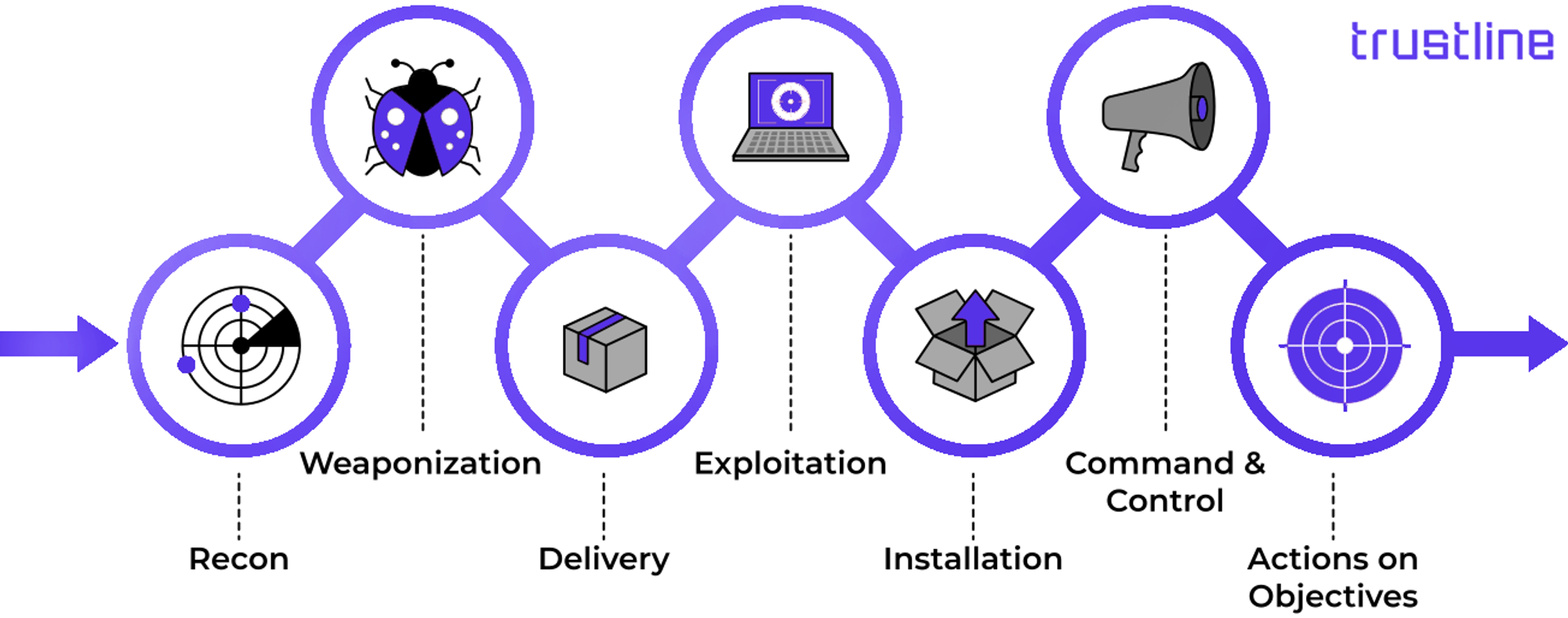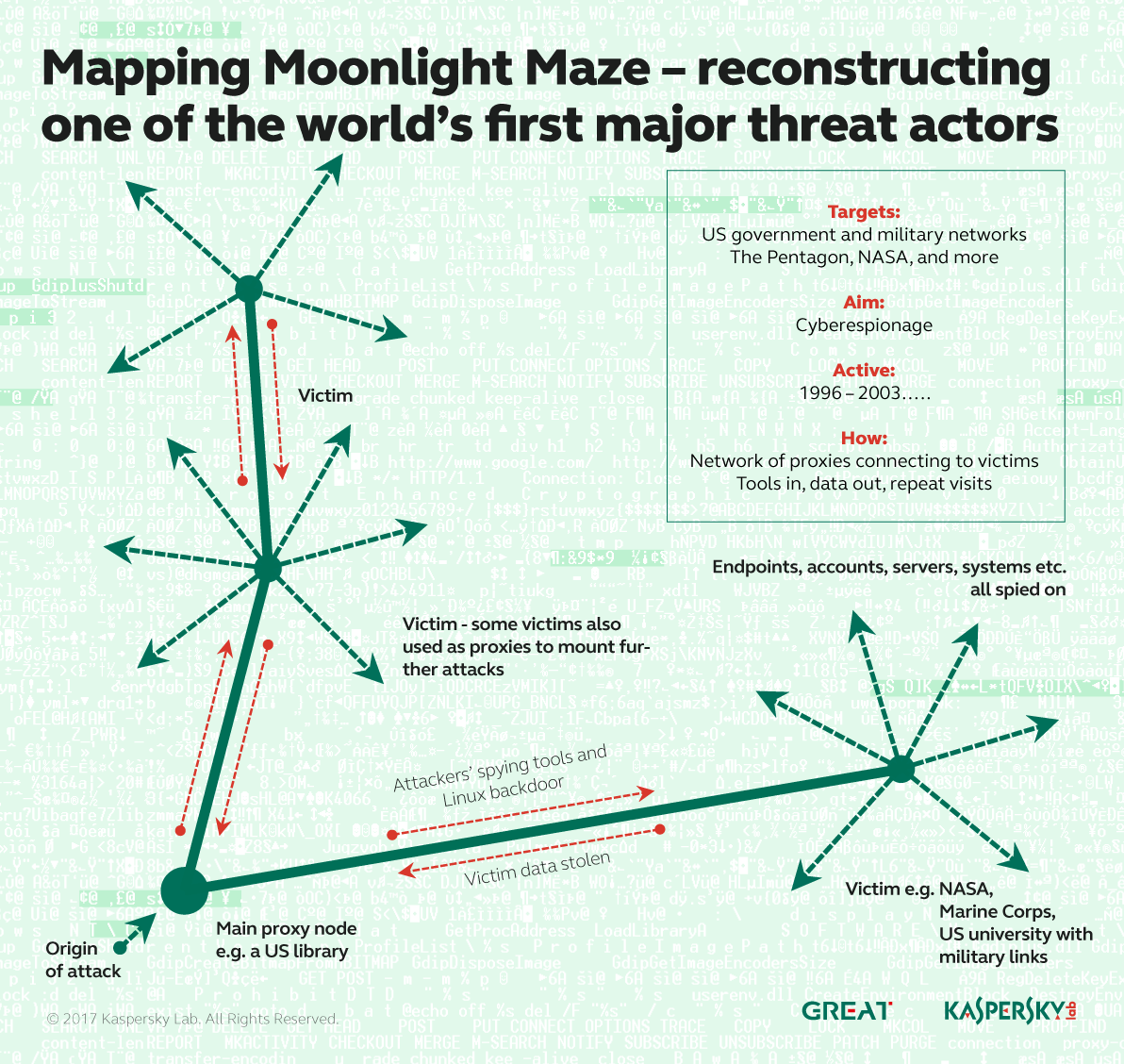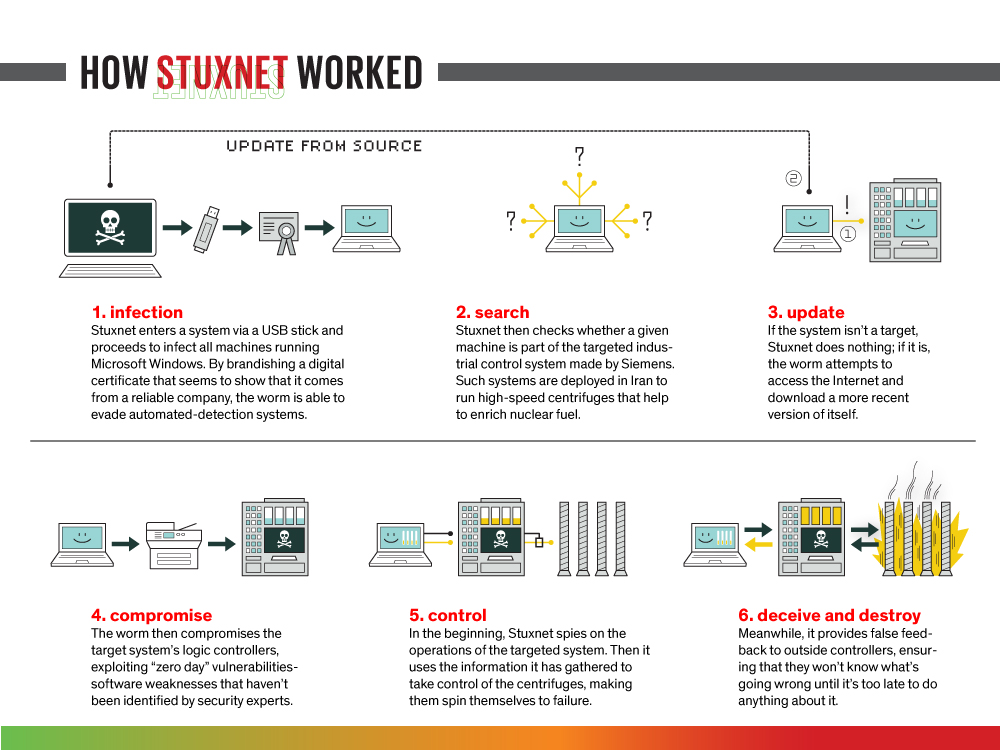Inside the Digital Battlefield: The Evolution of Cyber Warfare
- 4 minutes read - 825 wordsCyber Warfare: The Digital Frontline
Cyber operations have come a long way, evolving from obscure espionage missions to full-scale digital warfare. These operations shape modern technology, influence global conflicts, and redefine the meaning of security in a hyper-connected world. Today, we’re diving into the strategic goals of cyber operations, the infamous Moonlight Maze and Stuxnet incidents, and the laws they helped bring into existence. Buckle up—this is where cybersecurity meets history.
The Cyber Kill Chain: How Operations Unfold
Cyber operations aren’t just about launching attacks—they’re meticulously planned, strategic endeavors designed to achieve specific objectives. They follow a structured process that unfolds in seven key stages:
 Source: Trustline - Cyber Kill Chain
Source: Trustline - Cyber Kill Chain
- Target Recognition – Identifying high-value targets, mapping out systems, and assessing vulnerabilities.
- Reconnaissance – Gathering intelligence on network defenses, user activity, and security measures.
- Gaining Access – Exploiting weaknesses or using social engineering to infiltrate the target system.
- Hiding Presence – Deploying stealth techniques like rootkits and encryption to avoid detection.
- Establishing Persistence – Setting up backdoors and continuous access mechanisms to maintain control.
- Execution – Carrying out the mission, whether it’s data theft, system disruption, or sabotage.
- Assessment – Evaluating the operation’s success and refining tactics for future missions.
With this playbook in mind, let’s examine two of the most notorious cyber operations in history.
Moonlight Maze: The Birth of Modern Cyber Espionage
In the late 1990s, a sophisticated cyber-espionage campaign, later dubbed Moonlight Maze, was uncovered. Targeting U.S. government agencies, research institutions, and military organizations, the attackers systematically infiltrated networks to extract classified intelligence.

Source: Security Affairs - Moonlight Maze and Turla APT
- Objective: Gather sensitive data on U.S. defense and technology.
- Tactics: Exploiting unpatched vulnerabilities, weak passwords, and poor system defenses.
- Impact: Years of undetected access resulted in massive data exfiltration, forcing the U.S. to rethink its cybersecurity posture.
The Aftermath: Cybersecurity Gets Serious
Moonlight Maze was a wake-up call. In response, the U.S. implemented Presidential Decision Directive 63 (PDD-63) to enhance critical infrastructure protection and foster public-private cybersecurity collaboration. Additionally, the National Infrastructure Protection Center (NIPC) was created to monitor threats and facilitate communication between government agencies and private entities.
Stuxnet: The World’s First Cyber Weapon
Fast forward to 2010, and we see the emergence of Stuxnet, a game-changer in cyber warfare. Unlike espionage-focused operations, Stuxnet was a full-blown cyber weapon designed to cause physical destruction.

Source: IEEE Spectrum - The Real Story of Stuxnet
- Objective: Sabotage Iran’s nuclear program by crippling its uranium enrichment centrifuges.
- Tactics: Delivered via USB to bypass air-gapped networks, exploiting zero-day vulnerabilities, and using stolen digital certificates for legitimacy.
- Impact: Stuxnet successfully disrupted Iran’s nuclear ambitions and set a precedent for using malware as a geopolitical tool.
Stuxnet’s Legacy: Strengthening Critical Infrastructure
The revelation of Stuxnet exposed vulnerabilities in industrial control systems, prompting a wave of regulatory action. The U.S. responded with Executive Order 13636, aimed at bolstering critical infrastructure security. Additionally, the NIST Cybersecurity Framework was introduced, providing standardized guidelines to help organizations detect, prevent, and respond to cyber threats.
Lessons from the Cyber Battlefield
Moonlight Maze and Stuxnet serve as stark reminders of how cyber operations have evolved from espionage to full-scale cyber warfare. These incidents underscore the need for robust security measures, collaboration between governments and industries, and a proactive approach to defending against ever-sophisticated threats.
The digital battlefield is constantly shifting. Whether you’re an individual, a business, or a nation-state, staying ahead requires vigilance, innovation, and a deep understanding of how cyber warfare operates. Welcome to the frontlines of cybersecurity—where every line of code can mean the difference between defense and disaster.
Thanks for reading,
Michael
If you enjoy the content, then consider buying me a coffee.
P.S. Stay updated on the latest cybersecurity trends and best practices by subscribing to our newsletter or leaving your thoughts in the comments below! Visit CyberSHIELD
Sources
Çetinkaya, Şeref, and Sami Terzi. “Analysing The Effects of Cyber Security on National Security From A Realist Perspective: ‘Stuxnet’ Example.” Turkish Journal of Security Studies / Güvenlik Calışmalari Dergisi, vol. 26, no. 1, June 2024, pp. 38–51.
Marko Arik, et al. “Optimizing Offensive Cyber Operation Planner‘s Development: Exploring Tailored Training Paths and Framework Evolution.” Frontiers in Computer Science, vol. 6, June 2024.
Watford, Jeremy. “A New Framework for Cyber Operations: Reevaluating Traditional Military Activities and Intelligence Collection in the Digital Age.” Journal of National Security Law & Policy, vol. 14, no. 1, Jan. 2024, pp. 151–77.
Sule, Babayo, et al. “Countering Cybercrimes as the Strategy of Enhancing Sustainable Digital Economy in Nigeria.” Journal of Financial Crime, vol. 30, no. 6, Dec. 2023, pp. 1557–74.
Atkins, Sean, and Chappell Lawson. “An Improvised Patchwork: Success and Failure in Cybersecurity Policy for Critical Infrastructure.” Public Administration Review, vol. 81, no. 5, Sept. 2021, pp. 847–61.
Perols, Rebecca R. “The Impact of the Type of Cybersecurity Assurance Service and Cybersecurity Incidents on Investor Perceptions and Decisions.” Auditing: A Journal of Practice & Theory, vol. 43, no. 3, Aug. 2024, pp. 187–202.